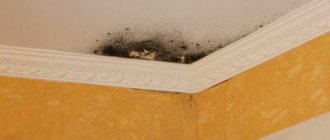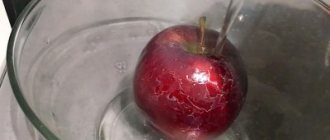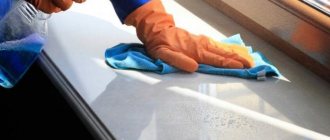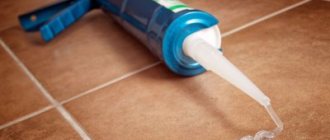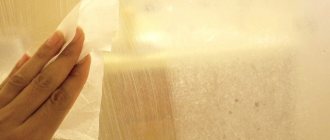Pleasant, refreshing air is an indicator of the cleanliness of the bathroom.
However, in some cases, an irritating sewer odor may appear, which not only causes discomfort, but also poses a health hazard.
Therefore, if alarming signs appear, you should definitely find out and eliminate the cause of the problem, and use preventive measures in the future.
We will tell you in this article how to remove the smell from the bathroom drain.
Causes of smell in the bathroom
The most important thing is to accurately determine the source of the unpleasant odor. In the bathroom most often it is:
- clogged sewer pipes;
- problems with the siphon . To prevent odors from the sewer from penetrating into the bathroom, a siphon holds the water plug. If you smell sewage in your bathroom, then most likely there is something wrong with the siphon. It may be installed below the sewer pipe connection. Perhaps the sewer system in the house has simply not been used for a long time, the water has dried up, giving way to unpleasant odors. Another reason is improper fixation or too long use of corrugated pipes. The siphon may simply become clogged, and deposits in it begin to decompose and emit unpleasant odors. This is usually a problem in the kitchen, but it can happen in the bathroom too;
- visible and invisible leaks . Often occur at pipe junctions. At first, literally drops of water may leak out, which will be absorbed into the finishing materials, causing the appearance of mold (where there was none before) and odor;
- poor ventilation . Perhaps the general house ventilation system is clogged, or the problem is at the junction of the individual part of the ventilation with the general one. If the air from the bathroom is not properly removed, the smell will soon be very unpleasant;
- insufficient slope of sewer pipes, as a result of which wastewater stagnates;
- high pressure in the sewer caused by blockages, small diameter channels, icing. The result is that air bubbles pass through the siphon, and with them an unpleasant odor;
- dampness _ We noticed that a damp towel left in the bathroom hardly dries, and then begins to emit an unpleasant odor. Moreover, dampness and warmth are excellent conditions for the development of mold. To reduce the level of dampness in the bathroom, eliminate leaks in taps and mixers, install a border between the bathtub and the wall to prevent water from accumulating there, prevent the cistern from leaking, and dry wet towels and bathrobes on a heated towel rail or outside the bathroom;
- dirty laundry in the washing machine is the most common and easily detected source of odor.
The worst thing is the incorrect installation of sewer pipes specifically in your bathroom. Then you will need a complete replacement of the entire system. In most cases, it is possible to escape with little blood and easily get rid of the smell, however, in each specific case the principle of action will be different.
Why is sewer smell dangerous in the bathroom? A spoiled mood is the tip of the iceberg. Towels soaked in a disgusting smell are not so bad either. But inhalation of methane, hydrogen sulfide, ammonia and other compounds can provoke insomnia, anxiety, irritability and even hypoxia, bronchitis, and vapor poisoning.
Why is ambre from the drain dangerous?
The composition of sewage water is rich in ammonia, hydrogen sulfide, methane and other substances that are formed during the decomposition of organic matter. Many of these compounds evaporate and enter the human respiratory tract with the air.
Most gases are poisonous and, if continuously inhaled, cause serious health problems for residents:
anxiety, nervousness;- irritable behavior;
- sleep disturbance;
- rhinitis;
- bronchitis;
- nausea, vomiting;
- migraine;
- dizziness;
- pressure disturbance;
- blurred vision.
Prolonged exposure to persistent sewer vapors can lead to general intoxication and illnesses requiring medical intervention.
Removing sewer clogs
All plumbing fixtures are checked one by one with a powerful jet of water.
If somewhere the water is reluctant to drain, then we are dealing with a blockage, which can give off unpleasant odors. Although clogs are usually obvious when using your plumbing fixtures on a daily basis. deal with sewer blockages in the following ways:
- mechanical cleaning. This is a well-known plunger that will help with minor blockages and if the contamination is located close to the drain. For more complex cases, a plumbing cable , which is inserted into the pipe with rotational movements, reaching the blockage and removing it, and then rinsing everything with hot water. If the pipe has a complex shape, then it is almost impossible to cope;
- simple folk remedies for small blockages: pour half a pack of soda or salt into the drain, and after 20-30 minutes rinse it with hot water;
- half a glass of soda is poured into the drain, then a glass of vinegar is poured. The drain is covered with a cloth or stopper. After 30 minutes, the pipe is washed with boiling water;
- soda and citric acid are a famous duet that, once in the drain, begins to hiss and form foam. When the reaction stops, hot water is poured into the pipe;
- undiluted white is poured into the drain for 20 minutes, then washed with hot water;
How to quickly eliminate odor
The lack of water in the toilet water seal can be detected with the naked eye. To remove an unpleasant odor, simply drain the water, creating a clean water plug. If the water level in the drain remains low, then the problem lies in improper installation (siphon, drain pipe, etc.).
If the problem persists after filling the water seal, then the ventilation and sewer systems should be cleaned. If you suspect a leak, you should inspect the joints and then wrap them with toilet paper. A change in the color of the adsorbent will indicate a depressurized connection.
If home measures have no effect, it is necessary to call specialists who will determine the area of the leak or improper installation of pipes . To search for damage, special devices are used: thermal imagers, acoustic leak detectors, etc.
If the smell is due to the presence of a hidden sewer leak, then the owners will have to dismantle the cladding and part of the ceiling.
Improved ventilation draft
Cleaning the ventilation duct is performed in the following sequence:
- Remove the decorative grille. Clean it from dust, dirt and cobwebs, rinse thoroughly.
- Wear gloves and sweep out small and large debris from the ventilation duct.
- Clean the canal deeply with a dry and clean toilet brush. Vacuum the remaining dust and cobwebs with a pipe without attachments.
- Clean the canal walls from dirt using a damp sponge and scraper. Detergents and chemical solvents are not recommended.
- Reinstall the clean decorative grille. Check the ventilation draft.
- For more thorough cleaning, you can use a flexible shaft and a stiff brush, the diameter of which is approximately equal to the width of the ventilation duct. The structure of the shaft and brush is put on the drill, which rotates at low speeds. Before starting work, it is recommended to mark the height of the floor with the ceiling on the cable. When the end of the brush hits a solid obstacle and the mark reaches the exit of the channel, the shaft can be removed.
Ventilation needs to be improved.
If there is no draft even after cleaning, then the problem may occur in several apartments or on all floors. To “break through” a ventilation duct in a common building system, you need to call specialists from the management company or the housing office.
Home methods for cleaning pipes
If an obstacle occurs in the pipeline, the water in the water seals is not renewed, and the incoming waste begins to decompose and emit a stench.
You can get rid of the blockage using the following means:
- Table salt and soda. The method is only suitable for preventing blockages and gently cleaning the walls of the sewer. You need to pour 150-200 g of salt and soda into the drain, add hot water and leave for 2-3 hours. The product is used to clean sink drains. More effective chemicals are required to dissolve hair and impurities.
- Vinegar and soda. The problem may arise not in the bathroom system, but in the apartment’s general sewer system. In this case, the likely cause of the blockage is fatty deposits. They are effectively eliminated with a combination of vinegar, baking soda and hot water. To clean the pipe, you need to remove the metal mesh from the drain hole, pour 100-150 g of soda into it and pour in 200-250 ml of vinegar (6%). After this, close the drain with a stopper and wait 2-4 hours. The last step of the procedure is pouring 1-1.5 liters of boiling water. The cleaned drain is washed with running water.
- Soda and plunger. The combination of home remedies and mechanical action allows you to do without strong chemicals. First you need to pour 1 liter of boiling water into the pipe, wait 10-15 minutes and use a plunger. If it was not possible to break through the blockage, you need to pour 150-200 g of soda into the drain, pour 1 liter of boiling water, wait and use the plunger again. The procedure can be repeated 2-3 times.
- Plumbing cable. A flexible steel rope with a hook attachment is suitable for removing dense blockages and large debris. To clean the drain, it is screwed in and pushed into the pipe until the obstruction disappears. It is not recommended to pierce corrugated connections with a cable, because a sharp nozzle can tear thin walls.
- Chemical reagents. Tornado, Bagi Potchan and Mr granules are used to remove blockages. Muscle, Chirton powder, liquid Mole, DEBOUCHER Active and Synergetic, Sanfor, Chistin, Tiret and Sanox gels. Some products (for example, Tiret) are not intended for cleaning toilet drains. Reagents are poured or poured into the drain hole. After 5-15 minutes of action, the sewer is washed with hot water.
For thorough cleaning, it is recommended to remove the corrugation or disassemble the siphon. Flushing the pipeline section will remove grease, dirt and organic waste from the walls.
Normalization of ventilation
After blockages, poor ventilation is the second reason for the appearance of unpleasant odors in the bathroom. to check the presence of draft : bring the flame of a candle, lighter or match to the ventilation grille, and if it remains vertical and does not lean towards the ventilation hole, then things are bad.
Why ventilation does not work well:
- large debris entered the canal;
- the neighbors have forced ventilation;
- The bathroom has doors that do not let air flow through.
Large debris can be found by shining a flashlight into the vent. If there is something like a piece of brick lying there, then it is worth removing it. It doesn’t hurt to clean the walls of the shaft from dirt with a brush, and then remove the remaining dust with a vacuum cleaner without an attachment. After this, the grille is put back in place and the traction is checked again. Often such a simple set of measures can significantly improve the quality of ventilation in the bathroom. The door, especially in the summer, should be left ajar at least sometimes.
If everything is fine with the draft, then ventilation can be improved by installing a decorative grille at the bottom of the door, but this option is not acceptable for everyone. The most effective and at the same time the most expensive method is to install a fan in the ventilation duct to provide forced ventilation.
Sewer stench is dangerous
The sewer smell is impossible to get used to. Volatile gases coming from the siphon and pipes spread throughout all areas of the house or apartment. This stench is disgusting and spoils the mood. When guests arrive, the owners of the “fragrant” home have to apologize and make excuses.
Psychological discomfort is far from the worst thing that sewer stench brings with it. What is much worse is that it is dangerous to health. The ability to separate odors into pleasant and unpleasant is a biological mechanism that has ensured the survival of humanity for thousands of years. If the aroma seems unpleasant, it means it is potentially dangerous.
The air from the sewer system is “flavored” with ammonia and hydrogen sulfide. It also contains methane, which has no distinct odor. Volatile gases affect the state of the human nervous system. There may be a feeling of causeless anxiety, nervousness, and irritability.
The harm that sewer stench can cause to humans depends on the composition of the air and the concentration of toxic gases. In any case, the smell should be eliminated immediately as soon as it appears.
In a house that smells like sewer, people can become mopey, have breakdowns, have trouble sleeping, and even faint. Long-term exposure to hydrogen sulfide can lead to respiratory diseases: rhinitis, bronchitis.
With a high concentration of gas in the air, poisoning is possible, the symptoms of which are nausea, vomiting, headache, decreased blood pressure and dizziness.
Ammonia negatively affects vision, the respiratory system, causes a state of excitement, and has a general toxic effect. And methane can cause oxygen starvation of cells. Some disturbances in the functioning of the autonomic nervous system cannot be ruled out. For example, a “twitching eye” may well indicate long-term exposure to methane on the body.
At the first sign of a sewer smell in the bathroom or toilet, you should immediately begin to find the cause of the stench and eliminate it. Otherwise, the concentration of gases in the air will only increase, and this can lead to negative consequences for the health of the residents of the house.
Image gallery
Photo from
Interior of a combined bathroom
Connection to outlet via siphon
Regular and timely maintenance of plumbing fixtures
Effective ventilation to remove dirty air
Siphon cleaning
The siphon under the sink, bathtub or shower is a good place for bacteria to grow.
Hair, particles of cosmetics, and fat settle in it, and then cool and literally stick to the walls. This is an excellent environment for the growth of bacteria, and gradually the mass of sewage only becomes larger, causing not only an unpleasant odor, but also complicating the outflow of wastewater. If the cause of the unpleasant odor lies precisely in the siphon, then the procedure will be as follows:
- remove the siphon and clean it of adhering deposits. It is appropriate to place a basin or bucket under the siphon so as not to stain anything;
- wash the siphon walls with dishwashing detergent;
- install a clean siphon in place, ensuring the tightness of all joints;
- Use drain cleaners regularly to prevent sediment from accumulating there.
The siphon (hydraulic seal) takes on an important function in terms of protection against odors. Thanks to the existence of a water plug, stench simply cannot get into the apartment. Siphons come in bottle, tubular and corrugated types. The bottle type is ideal for the sink; it is easy to install. The cheapest option is a corrugated siphon.
How to find the source of the problem?
To calculate the cause, you need to sequentially check all possible points of problems. These include:
- Checking the ventilation system. A piece of paper or a lit match is applied to the hood grille. The deflection of the paper and flame towards the shaft indicates good air outflow.
- Search for leaks. Use a clean napkin to guide the sewer pipes. Particular attention is paid to the joints. Finding wet dirt indicates cracks or gaps.
- Determining the position of the sewer pipe. To do this, use a building level. It will show whether the required slope is available.
- Checking the drain. Testing is carried out by opening the water taps as much as possible. Stagnant or slow flow of water from a sink or bathtub indicates a blockage.
Ensuring the right amount of water in the siphon
From the above it follows that if there is not enough water in the siphon, an unpleasant aroma can spread throughout the bathroom.
It only takes a short period of time for all the water in the sink's water seal to dry out - you just don't use the sewer for a couple of weeks, and an unpleasant surprise awaits you when you return from vacation. Fortunately, this problem can be easily solved - just turn on the water, a water plug will form in the siphon again, and the smell will soon disappear. Popular wisdom suggests several ways to prevent the evaporation of water from the siphon. Before leaving, you can close the drain with a rubber stopper . Some people advise pouring sunflower oil into the drain, and upon returning, rinse the drain with an alkaline solution and plenty of hot water, but this seems too radical.
The water may not dry out completely - there just may not be enough of it. This problem is related to the shape of the siphon and is typical for S-shaped corrugated siphons. In this case, it is enough to simply install a few clamps to give the pipe the correct S-shape.
The most unpleasant option is when water from the siphon is forcibly sucked into the sewer, which is accompanied by characteristic bubbling sounds. This is usually the fault of neighbors who interfered with the sewer system of an apartment building and removed the drain pipe leading to the roof. The situation can only be corrected by reinstalling the drain pipe or choosing a high-quality aerator.
Ventilation pipe problems
An equally common cause is ventilation pipes. All it takes is a slight twist or deviation from the correct location to create an unpleasant odor. Also, due to prolonged use, plaque may develop inside the pipe. In such a situation, the pipeline must be cleaned so that it can again perform its function.
To prevent this from happening, it is advisable to periodically inspect the ventilation and promptly remove contaminants that could become a source of stench.
Correct installation of the bottle siphon
The design of a bottle siphon is quite simple, and installing it is not very difficult, but still a common mistake occurs when the vertical pipe is higher than the water level.
In this case, the smell from the sewer freely seeps into the bathroom. The way out of the situation is to install the siphon correctly. If you come across a design where the immersion level of the pipe can be adjusted, then solving the problem will be somewhat easier.
Gentle prevention of waste systems
Supporters of everything environmentally friendly, as well as owners of private houses with autonomous treatment plants, are recommended to choose modern bio-friendly preparations or folk remedies to prevent sewage pollution. If such biochemistry does not seem too cheap to you, then to get rid of the bad “aroma” from sewers:
- pour 2 tablespoons of salt into the drain hole of a bathtub or shower stall for an hour. Then rinse with plenty of cold water;
- 1-2 tablespoons of baking soda should be regularly poured into sink siphons that gradually become overgrown with fatty deposits in bathrooms, and especially in kitchens. Leave everything overnight, and in the morning rinse thoroughly with hot water;
- An effervescent reaction of a mixture of soda and vinegar gives a good preventive effect. First, 4 tablespoons of regular soda are poured into the drain, after which half a glass of vinegar is poured there. As a result of abundant gas release, as well as the effect of soda and acid on mud deposits, sewer pipes are cleaned. After the reaction is complete, wait a little and rinse the system with hot water.
Restoring the tightness of the sewer system
Cracks, punctures, ruptures and other defects may form on the siphon, pipes, and joints that impair the tightness of the sewer system. These places allow unpleasant odors to penetrate into the bathroom, and water also leaks through them, which sooner or later will also make itself felt with a characteristic aroma. The procedure for this case is as follows:
- thorough inspection and leak detection. Run hot water down the drain and inspect the pipes with a flashlight. You can use napkins or toilet paper - they will get wet upon contact with the problem area;
- if a defect is found on a non-separable element, it needs to be replaced. Poor quality pipes are often to blame;
- if water seeps through the joint between different elements, then first you can try tightening the connection or replacing the sealing gasket. You can also try sealing the joint with FUM tape;
- As a preventative measure, make it a rule to use silicone when installing all gaskets.
Possible installation errors
Errors during the installation of siphons can be as follows:
- The pipe is not immersed in the water correctly. This oversight is very common, because of this, an unpleasant aroma penetrates the room through the space between the walls of the siphon and the water.
- Tension when installing corrugated pipe. Plumbers who are not particularly skilled can also commit negligence.
- Shortened siphon partition. This causes the water seal to be too small, it periodically breaks and the water escapes. There is only one way to solve this problem - replace the siphon.
- The corrugated pipe was bent. In such a situation, you can bring it to its normal position and secure it with electrical tape. But this is only a temporary measure; in the future you need to buy a new pipe.
- Incorrect installation of the siphon (for example, upside down).
- Lack of plumbing maintenance. Prolonged stagnation of water can cause evaporation of water stagnant in the siphon. Namely, this liquid, which is constantly present in the device, does not allow bad odors to penetrate into the room from the sewer.
These situations are usually the main reasons for the formation of an unpleasant odor. Contamination of pipes can occur even during short-term operation of the pipeline. In these situations, not only a slight coating forms on it, but also real traces of rot and mold in the system, as well as various manifestations of bacterial activity.
An unpleasant smell from pipes in the bathroom can also occur if the diameter of the riser is too small. According to standards, it must be at least 11 centimeters. If this value is less, the passage of drains may be difficult, and this will cause blockages, which, in turn, will lead to the appearance of an unpleasant odor.
In this situation, replacing pipes with products with a larger diameter should be done by professionals who can do the job correctly. Trying to solve a problem on your own often leads to an even worse situation.
Minimizing joints in pipes
Joints are not only the weakest element in terms of leaks, but also a place where dirt and plaque easily accumulate, and where the characteristic smell is not far away. Often a huge number of joints are made when connecting the bathtub to the sewer. Unfortunately, it is only possible to properly detect and remove dirt from the joints by disassembling the drain. Chemical pipe cleaners will give a temporary and not the best effect.
If possible, try to reduce the number of joints as much as possible.
Elimination of sagging drain pipe
We are talking about the bathroom. They try to position it so that the drain hole is closer to the sewer outlet. It happens that you have to position the bath differently, and a long pipe connects the drain and sewer. If it is not made of the highest quality material, then over time it may begin to sag, water stagnates in this place, and since it contains a lot of fat and skin residues, bacteria immediately settle in this environment and begin to emit unpleasant odors.
If you look under the bathtub, you can determine the sagging by eye. If there is one, then it is enough to install a support under it to ensure a slight slope towards the sewer along the entire length of the drain. The minimum slope is 3 cm per linear meter, and preferably more.
Construction of the drainage system
The components of the sewer system include:
- pipes of various diameters necessary to drain water from the bathroom;
- ventilation and sewage risers;
- pressure manifold;
- water drainage lines.
Not only the bathroom, but also the shower room is connected to the system in a private house. The lowest point of the system is the wastewater outlet. A ventilation valve is installed on the top. This point is located above all water intake nodes. The functions of the valve include sealing the system so as not to allow harmful gases and odors to enter the room.
All outlets of the system into the collector are connected to the lower point ending with the siphon. This includes a bathroom and shower. All pipes must slope towards the collector well. An ideal sewer system does not have sharp turns of 90 degrees, and there are no changes in height within one branch.
Mold control
A humid, warm environment, lots of wet towels and gowns, and problems with ventilation are ideal conditions for mold to grow.
If you have ever heard this unpleasant smell, then you understand what we are talking about. Not only does it become difficult to be in the bathroom, but also inhaling such air is very dangerous. Particularly dangerous is black mold, which can affect any surface and ultimately lead to insomnia, dermatitis, asthma, pneumonia and even lung cancer. There are many ways to combat mold:
- ready-made special products are the most reliable option. Modern fungicides do an excellent job even with black mold, but when the mold has been overcome, it is better to periodically treat it with antiseptic agents for preventive purposes. Ideally, clean off all mold-affected layers of finishing, since the mycelium takes its roots very deep;
- Bleach is a worthy replacement for special products. It is diluted with water in a ratio of 1:10, then the whole thing is applied with a brush to the affected area;
- vinegar can also be sprayed onto the affected area and washed off with a damp cloth after a while;
- peroxide is poisonous to mold, but be careful - it will discolour painted surfaces. A 3% peroxide solution is applied directly to the damaged area;
- ammonia is mixed with water in a 1:1 ratio. Works effectively on hard, non-porous surfaces. Do not mix with bleach;
- borax (1 glass) is diluted in water (2.5 l), and the solution is applied with a stiff brush;
- also use tea tree oil, lavender and rosemary oil, potassium permanganate, soda, and citric acid. The smell of mold can remain even after it is removed, and you can eliminate it with baking soda. It is left in the place where the fungus lived, and then collected with a vacuum cleaner.
Effective ways to eliminate unpleasant odor
The problem with pipe laying is more difficult to solve, since this will require disassembling and reassembling the system. In a commissioned apartment building, these problems are required by law to be eliminated by the developer. In a private house - the team that dealt with the sewerage or the owner himself. These mistakes are usually costly, especially if the renovation is completely finished and the tiles need to be broken.
As for the siphon, over time the corrugated pipe may lose its elasticity and original shape, so it should be replaced with a new one. It is advisable to use fittings made of durable plastic rather than corrugated material, as cracks quickly appear in it. The same problem can occur with the bathroom. Installing defective or cheap parts will lead to rapid failure of the repaired equipment. Cheap rubber from which the gaskets are made also deteriorates quickly.
A water seal failure is a construction problem in which the craftsmen made too much of a slope. Therefore, they first check the condition of the plumbing inside the apartment, and then measure the parameters of the installation of pipes in the overall system. If they are the problem, the stink will be in more than just one apartment.
Cracks in the plastic line are eliminated by replacing a section of the pipe or using a sealant to temporarily stop the leak. It is more difficult with cast iron products. You can urgently remove a leak with cement mortar by covering the crack with it.
Ventilation problems arise for all residents of an apartment building at once, since one shaft serves several apartments. If you apply a piece of paper while the fan is running, it will stay on the grille. If the traction is bad, it will fall. To clean the ventilation pipe, call specialists. There is special equipment for this work that quickly removes dirt and dust.
Ways to remove blockages
Cleaning kitchen drains and bathroom drains regularly will prevent clogs from forming. To do this, use acid-based powders once a week. They are poured into the drain, filled with a glass of water, as written in the instructions, and left for a couple of hours. When the acid eats away the fat, the pipes are washed several times with hot water.
Persistent plugs are removed with a plumbing cable with a nozzle at the end; after freeing the pipe from scale or grease, it is advisable to use a liquid cleaning agent, and then boiling water.
Prevention of odor
In most cases, solving the problem of unpleasant odor in the bathroom is indeed not difficult, but it is even easier to never encounter such a problem, so it is still worth knowing about some preventive measures:
- simple mesh filters on the drain holes trap a huge amount of dirt, preventing rapid clogging of the sewer and the appearance of aroma;
- to clean pipes with special means once every couple of months, without waiting for a serious problem. Plaque still remains on the pipes, and it is important to “wash it off” in time, since other contaminants stick to it well;
- It is generally better to remove debris and grease from the siphon once a month;
- The draft in the ventilation duct should be checked twice a year;
- make it a rule to regularly inspect the joints of sewer pipes;
- Before leaving, cover the drain holes with a lid;
- do not forget to wash the toilet seat mounts . It is necessary to remove all elements and carefully wipe under the fasteners. These are the places where the most dirt collects. In the future, you should occasionally wipe under the seat with a brush to prevent odor;
- Use lemon cleaner to clean surfaces. It is important to buy quality substances; you should not skimp on such products;
- To fill your bath with a pleasant aroma, you can make your own air freshener . You will need a diffuser with essential oil, water and witch hazel. For a more lasting aroma, it is worth adding a few drops of peppermint oil to the solution;
- To bring a pleasant smell into the bathroom, you can make washers from essential oil and soda . Mix half a cup of baking soda and a few drops of essential oil. You should get a paste of medium thickness. Can be poured into muffin tins. We put the washers on shelves in the bathroom, a basket for dirty laundry and use them as an air freshener;
- If towels are constantly in the bathroom , wash them with the addition of vinegar. Instead of conditioner, add half a cup of purified vinegar and wash at high temperature. Then you should dry the laundry in the fresh air;
- even if the ventilation is fine, sometimes leave the door open to reduce the humidity in the bathroom.
If possible, dry towels and bathrobes on a heated towel rail or on the balcony. Do not leave dirty laundry in the washing machine or a special bucket for too long, and in general, try to clean all surfaces in the bathroom regularly. If you are too lazy to do this yourself, you can always hire a contractor to enjoy cleanliness and pleasant aromas in the bathroom.
The article was written for the site.
Tags:Bathroom, lifehack, Cleaning
Operating principle of a fan pipe
All liquids in the sewer move by gravity. This means that the only driving force is gravity. If there is no hole in the vertical riser for air to pass through, the liquid will not flow down and will stop. To eliminate this situation, all risers have access to the roof and are open at the top. The outer part located on the roof surface is called an aerator. It ensures the removal of biogas and ventilation of the system. The incoming air does not allow the water to stop under the influence of its own elasticity. In addition, a hole in the top allows sewer gases to escape.
The section of the riser that faces the roof is called the fan pipe. The quality of operation of the entire riser and branches to apartments in a high-rise building or private house largely depends on its condition. If the drain pipe is clogged or blocked, the operation of the system is at risk of blockages that contribute to the accumulation of harmful gases.
Sewer pipe - responsible for ventilation and pressure in the sewer pipe, one of the important elements of the system
The autonomous sewage system of a private house, the main element of which is a septic tank, also requires a drain pipe. During the process of settling and processing wastewater in tanks, a large amount of gases is released, which is removed through aerators on the tanks themselves and on the roof of the house.
